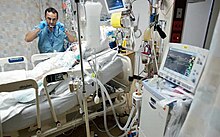Potencia mecánica

La potencia mecánica es un término médico que es una medida de la cantidad de energía suministrada a un paciente por un ventilador mecánico.[1][2][3][4][5]
Si bien en muchos casos la ventilación mecánica es una intervención que salva o preserva la vida, también tiene el potencial de causar daño al paciente, lo que se conoce como lesión pulmonar asociada con el ventilador. El ventilador puede inducir varias tensiones en el pulmón del paciente. Estos incluyen el barotrauma causado por la presión, el volutrauma causado por la distensión de los pulmones, el reotrauma causado por el flujo rápido de gases y el atelectotrauma que resulta del colapso y reapertura repetida del pulmón.
El propósito de la potencia mecánica es proporcionar una medida que pueda explicar todas estas tensiones y, por lo tanto, predecir la intensidad de la lesión pulmonar que es probable que se vea en el paciente.
Referencias
[editar]- ↑ Gattinoni L, Tonetti T, Cressoni M, Cadringher P, Herrmann P, Moerer O, Protti A. Causas de lesión pulmonar relacionadas con el ventilador: la potencia mecánica. Cuidados intensivos med . Octubre 2016; 42 (10): 1567-1575.
- ↑ Rahaman U. Mathematics of Ventilator-induced Lung Injury. Indian J Crit Care Med. 2017 Aug;21(8):521-524. PubMed [1]
- ↑ Tonetti T, Vasques F, Rapetti F, Maiolo G, Collino F, Romitti F, Camporota L. Driving pressure and mechanical power: new targets for VILI prevention. Ann Transl Med. 2017 Jul;5(14):286. PubMed [2]
- ↑ Gattinoni, Luciano; Marini, John J.; Collino, Francesca; Maiolo, Giorgia; Rapetti, Francesca; Tonetti, Tommaso; Vasques, Francesco; Quintel, Michael (12 de julio de 2017). «The future of mechanical ventilation: lessons from the present and the past». Critical Care 21 (1): 183. PMC 5508674. PMID 28701178. doi:10.1186/s13054-017-1750-x.
- ↑ Maia LA, Samary CS, Oliveira MV, Santos CL, Huhle R, Capelozzi VL. Impact of Different Ventilation Strategies on Driving Pressure, Mechanical Power, and Biological Markers During Open Abdominal Surgery in Rats. Anesth Analg. 2017 Oct;125(4):1364-1374. PubMed [3]
Text is available under the CC BY-SA 4.0 license; additional terms may apply.
Images, videos and audio are available under their respective licenses.
